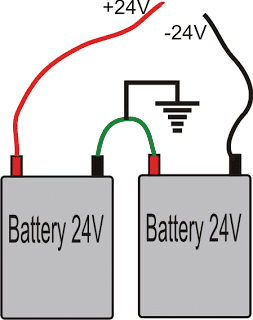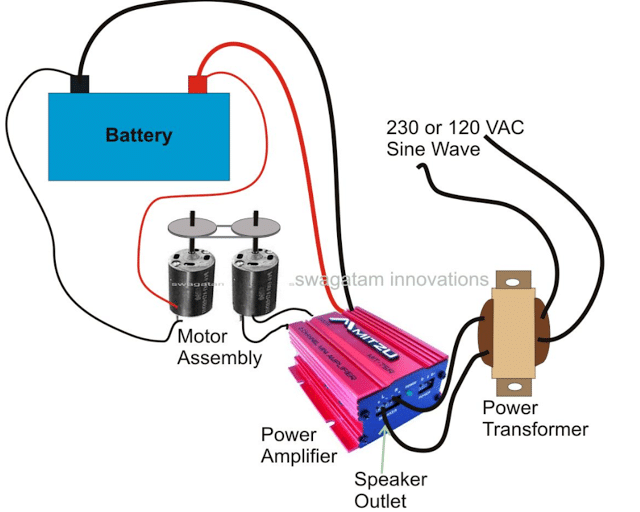If you are not too keen in understanding the deep technical aspects of a true sine wave power inverter, yet want to build it within a couple of hours, then this article will help you to accomplish it using an audio power amplifier and some DC motors. Here we'll how to convert audio amplifiers into pure sine wave inverters
We will consider 3 separate true sine wave inverter designs using appropriately dimensioned audio amplifiers, and digital sine wave generator circuits
Design#1
Let's begin by understanding how a couple of small DC motors can be used for generating pure sine wave signals and then proceed with the details of coupling the motors with a ready made power amplifier for acquiring the desired AC mains true sine wave power output. In this article I have explained an innovative idea of configuring a few ready made units like a power amplifier, a couple of DC motors and a battery into a sine wave power inverter.
There are folks whose lives depend on the power accessed from inverters and for them these gadgets are truly priceless and crucial. There are also individuals who intend to own inverters but are too ill informed regarding their technical specs etc and therefore are reluctant in bringing them home.
Another factor with inverters is that they can be immensely expensive, especially the ones which can be operated universally with all types of electrical appliances or simply the true sine wave inverters. I have already discussed many inverter circuit diagrams here ranging from the most ordinary hobby type idea to the very sophisticated modified sine wave and the true sine wave inverter types. However these designs are all too technical and definitely not meant for the layman.
The ideas explained are not simple and require prior expertise with electronics to understand them, and also a thorough knowledge regarding practical electronics to build them.So does it mean a lay man would be unable to understand these magnificent power houses? And does it mean that a layman is not entitled to enjoy the benefits of a homemade sine wave power inverter, which can be not only lot of fun to build but also very cheap and reliable as compared to the commercial counterparts.
The following section will clearly show how a sophisticated true sine wave inverter can be built by virtually anybody having ordinary technical skills and knowledge.
The idea I have explained below is not a circuit based unit which needs assembly using PCBs, electronic components etc. rather here we buy ready made units like amplifiers, motors, batteries, transformers etc. and integrate all these for constructing the final piece. Let’s learn how it can be done within an hour.
WARNING: THE CONCEPT IS ONLY ASSUMED BY THE AUTHOR AND HAS NEVER BEEN CHECKED OR VERIFIED PRACTICALLY, BUILD IT AT YOUR OWN RISK AND IF YOU HAVE SUFFICIENT FAITH ON THE FEASIBLITY OF THE EXPLAINED CONTENT.
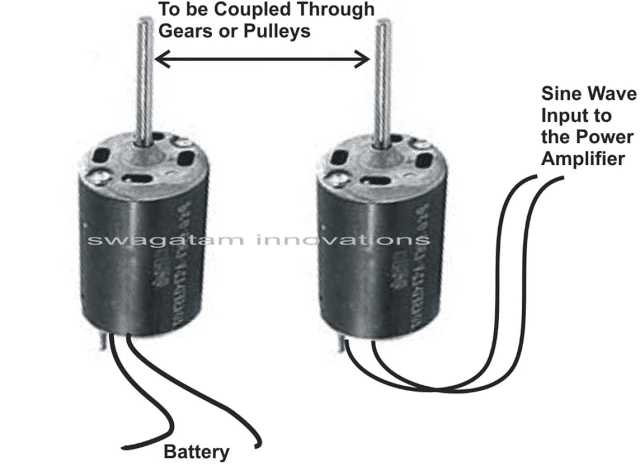
Basic Working Principle of Inverters
The Concept: Inverters as we all know are nothing but voltage amplifiers or steppers. The best known method of stepping up voltages is through transformers where isolated winding are used for achieving staggering voltage level multiplications. Basically the process takes place through magnetic inductions for transforming high current fluxes to high voltage outputs.
To comply with the above process, a high AC input is required which can be stuffed into the relevant winding of the transformer for getting the desired 230 or 120 volt AC power.
However since the whole purpose is to convert a DC source to mains levels, we first have to convert the low level DC to the low AC input. In square wave inverters this is easily achieved by using ordinary astable circuits, but a square wave output is what we are absolutely not looking for, so how do we actually “manufacture” a true or pure sine wave input for our prototype.
Using DC motors for generating Sine Signal instead of PWM circuits
Off course we can do it using complex opamp circuits like a “bubba” circuit, but since here we don’t want to involve much of electronics, a simpler solution would be to use a small DC motor for the purpose.A motor as we all know can be rotated by applying power to it, the rotations are caused by constant twisting interaction of the permanent magnet and the induced electromagnetic effect.
If we reverse the process, that i.e. if we rotate a motor by applying external mechanical force, we can induce a fair amount of varying potential across its winding terminals and the received voltage will have an sinusoidal wave form. The waveform will be perfectly natural and a true sine wave.
If this sine wave input is amplified to the desired levels, then perhaps our mission can be simply accomplished. Instead of embarking on complex mosfet circuits meant for inverter applications, I thought it was a better idea to feed the above sine input to a high power audio amplifier procured ready made from the market.
One such sample amplifier model is shown here. The outputs which are meant to be joined to speakers must be joined with our power transformers.
If the amplifier is a stereo then we can use a pair of transformers and terminate the AC outputs of the transformers to separate AC outlets so that different appliances can be connected to them.
The motor which actually manufactures the sine waves is driven by another motor attached with pulley/belt mechanism. The driving motor is operated with the available battery power.
Parts Required
You will require the following parts and units for the making this true sine wave inverter:
A ready made high power audio amplifier
Transformer – Rating should match with the power of the amplifier. If the amplifier can deliver 500 watts at 50 volts, it means the input winding of the transformer must be rated at 50 volts and 10 Amps.
Alternatively the power amplifier’s power supply transformer can be removed and used for the purpose.
Motors – The RPM must be above 3000 and should be adjusted to exactly 3000 RPM so that a 50 z frequency can be achieved from it.
Suitable cabinet for accommodating the whole assembly.
Nut, bolts, washers, wires, battery etc.
Wiring Layout for the Proposed Sinewave Inverter using an Audio Amplifier
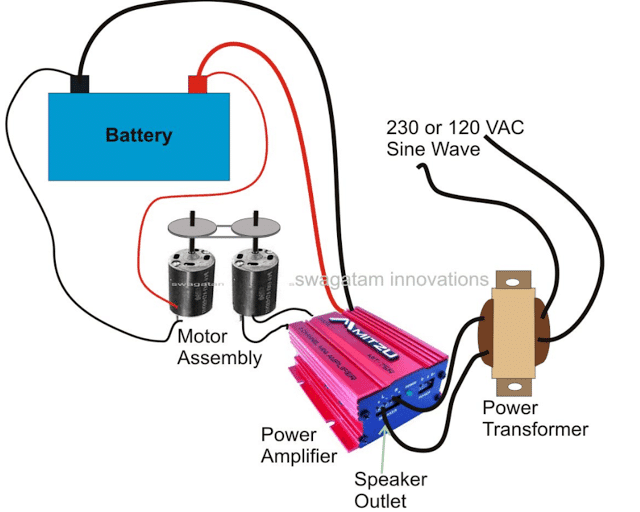
How to Assemble the Audio Amplifier with Battery and Sine Input
It’s quite simple and all about integrating the procured units as per the given diagram. The whole system along with the amplifier, transformer and the motors may be housed inside a bigger metal cabinet and fixed appropriately.
The motors especially must be tightly clamped with the base of the inverter cabinet to avoid vibrations and noise. The cabinet must also include all the terminals specified with the unit, fixed externally for the battery connection and the AC outlets.
Through a simple concept, the idea of building a pure sine wave inverter has been explained in the article. Read on to know the whole construction details.
Design#2: Using a 100 watt Amplifier Module
It’s understandable that sine wave inverters are not easy to build, due to many different reasons. But it’s probably the most sort after circuit and also pretty difficult to find. For the folks who are desperately looking for such a circuit, perhaps this article can help.
After a lot of thinking, I probably seem to have designed an easier (though not quite efficient) concept of a pure sine wave inverter circuit. Since the circuit has not been tested by me so won’t be able to tell much regarding the exact specifications of the circuit and would like to leave it up to the readers to decide the feasibility of the present circuit.
The idea struck me while reading the circuit description of a MOSFET audio amplifier. We all know that when an audio signal is fed at the input of an amplifier, it produces an amplified output power having exactly the same properties as the input.
That simply implies, in place of an audio signal if a pure AC signal say from a Wien bridge circuit is applied to the input of a power amplifier and an inverter transformer connected to its output (where normally a speaker would be connected), it would certainly produce an amplified replica of the input. And the secondary winding of the connected inverter transformer would definitely produce a sine wave AC power (My assumption).
The only big problem is the loss of a significant amount of battery power in the form of heat through the power devices reducing the overall efficiency of the inverter.
Let’s move on and see how the different stages of the proposed circuitt functions.
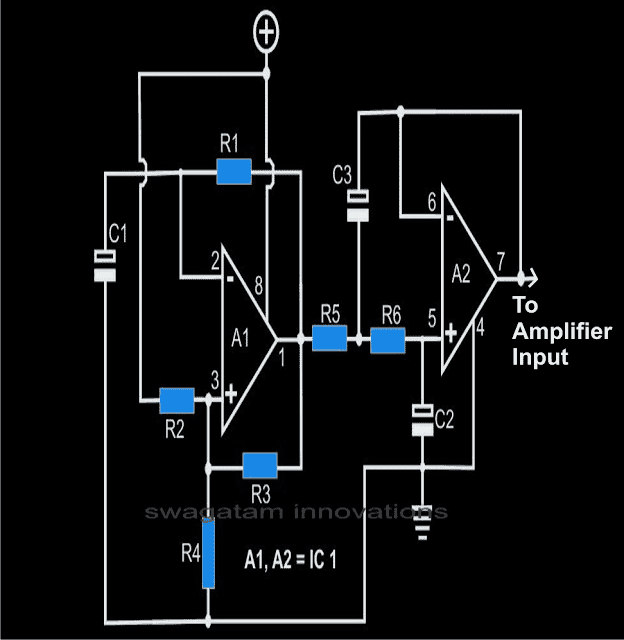
The Oscillator Circuit
The simple sine wave generator circuit shown alongside may be used to produce the required sine waves at the input of the power amplifier, let’s study regarding its functioning through the following steps:
Op amp A1 is basically wired as an astable multivibrator,
Resistor R1 and the capacitor C1 define the frequency of oscillation of the astable.
The square wave from A1 is fed to A2 which is configured as a double pole low pass filter and is used to filter out the harmonics from A1.
The output from A2 will be almost a pure sine wave, the peak will obviously be dependent on the supply voltage and on the type of the opamp used.
The frequency of the present circuit has been fixed to approximately 50 Hz. If the values of parts shown in the parenthesis are selected, the frequency will be around 60 Hz.
Parts List
All resistors are 1/8 watts, 1%, MFR
R1 = 14K3 (12K1),
R2, R3, R4, R7, R8 = 1K,
R5, R6 = 2K2 (1K9),
R9 = 20K
C1, C2 = 1µF, TANT.
C3 = 2µF, TANT (TWO 1µF IN PARALLEL)
C4, C6, C7 = 2µ2/25V,
C5 = 100µ/50v,
C8 = 22µF/25V
A1, A2 = TL 072
IC2 = LM3886 (National Semiconductor),
HEATSINK FOR IC2 AS SHOWN IN THE IMAGE,
TRANSFORMER = 0 – 24 V/8 AMPS. OUTPUT – 120/230 V AC
PCB = GENERAL PURPOSE
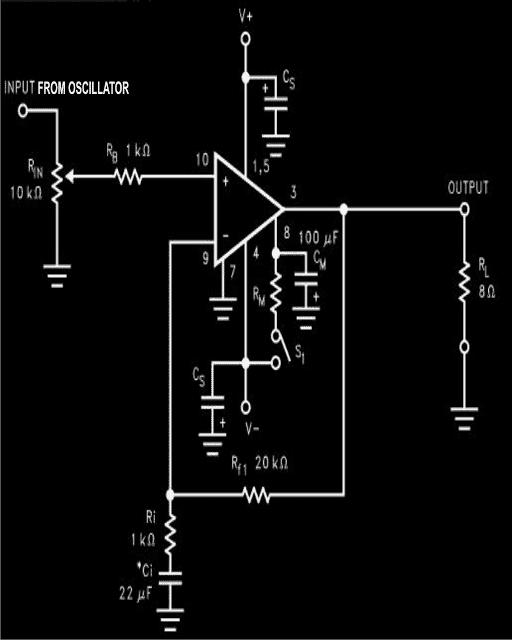
The Current Amplifier Circuit
In view of keeping the design specifications very simple, and the component count as minimum as possible, a single chip amplifier was the basic requirement. A reasonably powerful amplifier using IC LM3886 (National Semiconductor) was ultimately selected by me for the purpose. The salient features of this power amplifier chip are as follows:
Truly versatile and a high performance IC compared to the other types of hybrid and discrete devices.
Totally internally protected from instantaneous peak temperatures,
Has got a dynamically protected safe area of operation,
The out put is perfectly shielded against a short circuit with the ground or the positive supply through an internal current limiting circuit network.
The output is also protected against output over voltages due to inductive load transients,
Can be operated with voltages as low as 20 volts up to a staggering 94 volts.
Its technical specifications are as follows:
Input sensitivity is 1 Vrms
Output power will be in the vicinity of 100 watts if the transformer primary resistance is around 4 Ohms.
Power bandwidth is a massive 10 Hz to 100 KHz.
Construction Hints
The circuit basically consists of just two ICs as the main active components and a handful of other passive components, so the construction procedure should be very easy. The whole assembly may be simply done over a piece of general purpose board (approximately 4 by 4 inches).
IC2 should be positioned at the edge of the PCB to facilitate easy fitting of the heat sink. The present utilizes two large 24 volt truck batteries. Connect them as shown in the diagram.
A separate battery charger is required to charge the batteries.
Design#3: 500 W Pure Sine Wave Inverter
In this post I have explained how to make a 500 watt pure pure sine wave inverter using a 500 wat audio amplifier to get reasonably outstanding results.
The circuit basically uses a push pull topology through a couple of 24V batteries. The use of two 24V batteries allows lower AH batteries to be incorporated with higher efficiency and wattage.
12V batteries can be also tried however the power output would be reduced to half.
Since a dual supply is used the connected transformer does not need to be a center tapped type, rather a two wire ordinary transformer becomes suitable here.
The couple of designs shown below are all that would be required for implementing this simple pure sine wave inverter circuit.
The Sine wave Generator
The first circuit is the basic sine wave generator which becomes the feeding input to the main sine wave amplifier or the output stage.
The sine wave generator produces a pure sine wave output with the shown components at about 50Hz, for other frequencies the 2.5K resistor may be altered, and tested in a simulator for fixing the desired results.
The sine generator circuit should be supplied with +/-12V, and not directly from the 24V battery supply as that might damage the IC permanently.
The opamps used in this sine generator are from the IC TL072
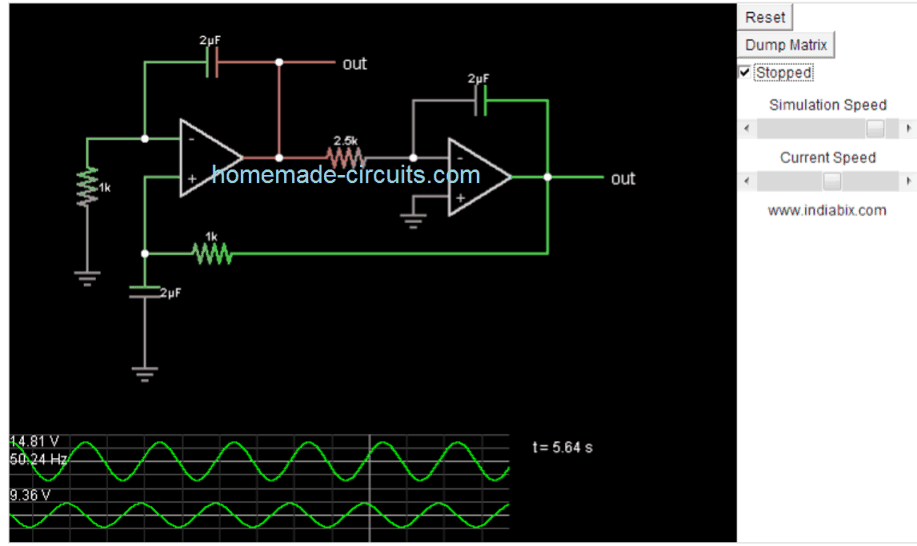
Using a Power Amplifier Circuit as an Inverter
The next diagram shows the output stage of the proposed simple pure sine wave inverter circuit which is actually a 500 watt power amplifier design. As can be seen the design is not at all complicated.
All the involved components are standard, and easily available.
The mosfets are IRF540n and IRF9540n which complement each other to produce the required push pull effect over the attached transformer.
With a 0-24V/25amp transformer, and a couple of 24V batteries the circuit would be able to generate as high as 600 watts of pure sine wave output at the relevant voltage.
The output across the right hand side opamp of the sine generator is to be connected across the input of the second circuit for initializing the proposed operations.
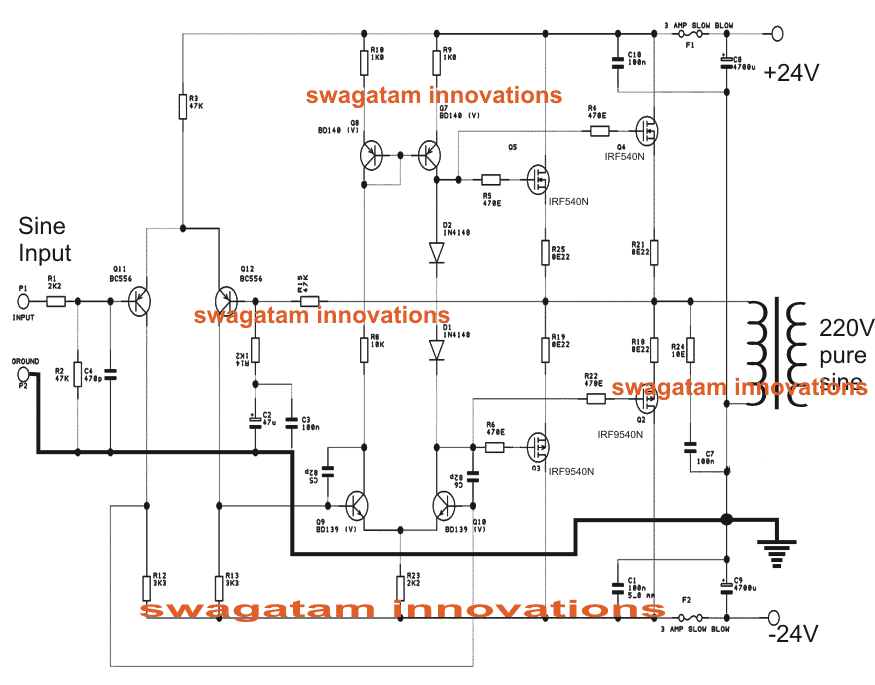
Battery Wiring Details for the above Simple Sine Wave Inverter Circuit
